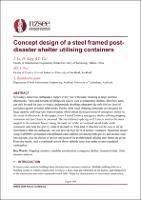| dc.description.abstract | Nowadays, numerous earthquakes happen every year with many resulting in large potential aftershocks. Tents and portable dwellings are widely used as emergency shelters. However, tents can only be used for days or weeks, and portable dwellings often provide only for low level of resistance against potential aftershocks. On the other hand, shipping containers are designed for large capacity and long-term transportation, which meets the requirement of emergency shelter in the event of aftershocks. In this paper, a new kind of 2-storey emergency shelter utilizing shipping containers and steel frame is proposed. The prefabricated splicing steel frame is used as the outer support to the container house, taking the most part of the vertical and lateral loads, while containers only bear the gravity loads of themselves. This kind of structure can be easy to set up immediately after an earthquake, and can provide high level of seismic resistance. Numerical model using SAP2000 is presented with different load combinations taking both gravity and seismic load into account, also the choice of section and joint of the prefabricated splicing steel frame are given. From the results, such a combined system shows reliable behaviour under several simulated earthquakes. | |

